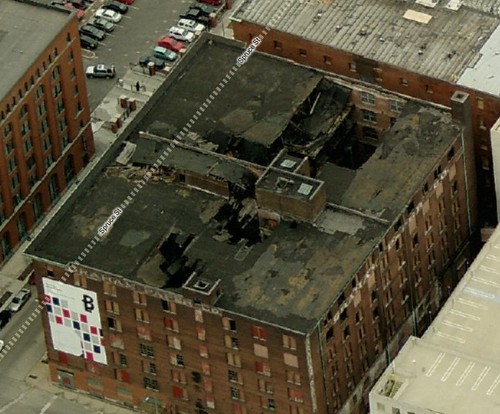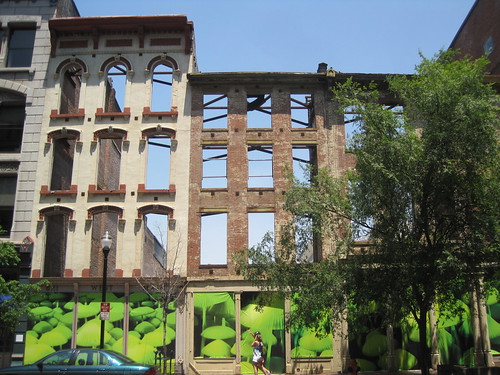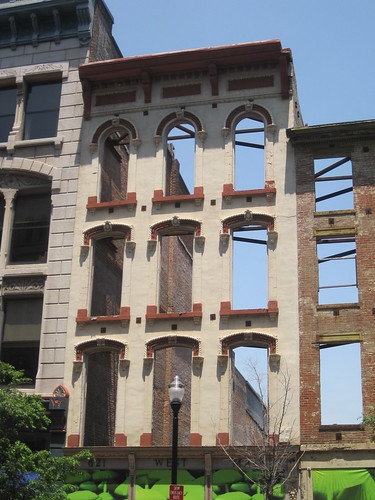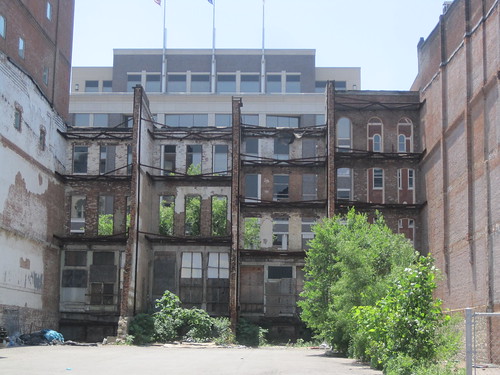by Michael R. Allen
Last Monday, the Preservation Board denied developer Kevin McGowan’s appeal of a denied demolition permit for the Cupples Station warehouse now known as Building 7. At the meeting, Cultural Resources Office Director Betsy Bradley, who denied the demolition permit, recommended that McGowan focus on stabilization of the damaged warehouse’s walls. Architect Paul Hohmann, who has worked on many rehabilitation projects that have involved structurally-damaged buildings, testified at the meeting that it might be feasible to brace the walls from the exterior. Such work could keep the building standing, allow the closed streets around the building to be reopened, and cost not much more than the estimates $675,000 demolition cost.

At the Preservation Board, attorney Bill Kuehling represented City Treasurer Larry Williams, and offered the dubious proposal in which the Treasurer’s Office would repay the $1.4 million that McGowan owes Montgomery Bank only if the building were demolished. Ostensibly the Treasurer is trying to protect its revenue from the hulking parking garage adjacent to Cupples 7, but inoffer its plan it is calling for the demolition of an official City Landmark. That a city official would ask a city board to not follow a city ordinance’s directions is absurd.
However more absurd were assertions by McGowan’s attorney Jerry Altman that stabilization of Cupples 7 would cost at least $8 million and would necessarily involve structural reconstruction and a new roof. That is not what the city is demanding, and sets up a false dichomtomy between expensive reconstruction and demolition. The middle path is simple, and probably costs less than the money the Treasurer wants to loan McGowan — maybe even closer to the over $300,000 that McGowan owes the city in unpaid property taxes. This is where leadership from the city, especially Mayor Francis Slay, could set a path toward a reasonable plan for stabilization of Cupples 7.

In Louisville, city leaders required developers to safeguard three small, threatened facades on Main Street. The three 19th-century buildings at 615-21 Main Street are part of a cohesive 19th century block face, and their loss would have created a huge visual break. When developers proposed to build the Office for Metropolitan Architecture-designed Museum Plaza behind the buildings, the city made the developers stabilize the cultural resources they had purchased for the larger project.

Now that Museum Plaza is dead, at the least the city ensured these facades are retained for future development and the Main Street corridor’s architectural character remains intact. The developers even bragged about the stabilization when they announced that the project was over. Despite the cancellation of Museum Plaza, which would have brought world-class contemporary design to Louisville, the city still has a cultural achievement.

In the case of the facades, parts of the side walls and foundations are retained to provide backing support. The stabilization work consists of steel members placed between these walls and the facade to provide simple and effective bracing. The project was straightforward — as stabilization always is.
For the moment, the storefront openings on these three facades have become an open-air gallery for artist Chris Doyle, who has installed photographs from his project Scenes from the Underglow. Behind the facades is temporary surface parking — a functional use that is screened from Main Street. In the next decade, something new and creative will rise in that space. Cupples 7 is not quite as easy a project, but unlike the Louisville buildings it has the benefit of being freestanding and not connected to other buildings.
Louisville’s city government recently forged a compromise with another developer that will stabilize facades on historic Whiskey Row. Damaged buildings will be demolished, but the facades will be retained to maintain integrity of the streetscape. Again, that’s a a pretty simple undertaking, and one that will benefit future generations as well as the property’s developer. That’s what happens when city government makes historic preservation both a priority and — most importantly — a practice.

3 replies on “Learning From Louisville: Facade Stabilization Should Be Simple”
Great to hear that most of Whisky Row will be saved!
An official from the Treasurer’s office offered to demolish a historic downtown landmark.Â
Obviously demolishing buildings fits well with his new idea of bringing people to live downtown: “He believes our downtown should house a larger-living, urban
environment. Mr. Williams’ way of achieving maximum revitalization of
our urban center is through the cooperation and intercommunication of
the public and private sector.”
 I’m not sure stabilization would be quite as simple as the Louisville examples given the height and width of the walls involved. The city should take it for taxes and rebuild the structure up to the roof until a developer is found. While I don’t know the extent of the structural damage, it looks to me like saving the building is not out of the question. It is such a key site the city won’t lose money on it. I don’t understand the city not going after these owners in court long ago, forcing them to make stabilization repairs when problems became evident. I know there are other smaller buildings like the corner of Arsenal and Michigan (without a roof, look through the side window) or on Jefferson, across from McDonalds that I would think the full force of the law should come down on the owners to repair or sell. Both of these corner stores will likely come down because of neglect, the same as Cupples. The worse part is that all of these sites mentioned are all desirable locations that someone might do something with, although Cupples is an expensive proposition at this point. (Made that way through neglect)
So what is it, that building maintenance laws have no standing and owners can do what they want? What’s going on? It is absurd this occurs over and over again.